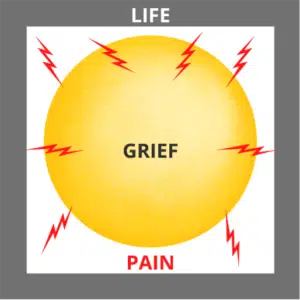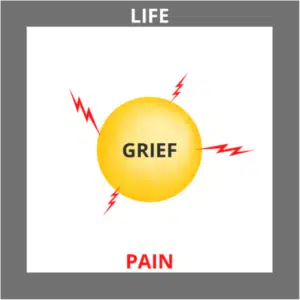Written By Stephanie Grunewald, PhD
The sad reality is that we all suffer loss in our lives. Loss can occur from many different situations, such as a breakup, death of a loved one, the death of a pet, or a lost job to name a few. Although loss is something we all experience, our understanding of the grief that follows is frequently misunderstood.
Ways to Conceptualize Grief
Whenever we talk about grief, many people think of the Kubler-Ross model – the 5 Stages of Grief. The error here is that Kubler-Ross created this model for those who are dying, not those who are grieving. As such, the application to those grieving is not how the model was intended and has led to many people feeling they are not grieving “properly”.
Life After Loss
We all grieve differently. Depending on the loss that triggered the grief, how intensely and how long you grieve may vary. Let’s use an analogy commonly used to describe grief: a bouncing ball in a box. Following this analogy, the ball bounces around as you go about your daily life. Each time it hits a side, pain is triggered.
Initially, when you’re first faced with loss, the grief can feel large and immense. That is, the gap between the ball and the sides is very small so the pain associated with grief is triggered often. A sound, smell, or particular date can trigger the pain button. In the beginning, it can feel like the ball leaves very little room for anything else in your life.

Over time, there are two theories about the change in the space between your grief (the ball) and how it impacts your life:
- Some believe the grief shrinks.
- Others believe you grow to accommodate it.
Either way, the space that was once occupied by the grief ball is replaced with memories and lessons. The increased space between the grief and your life continues to grow so the feelings are not activated as frequently. Your grief may no longer impact your life in the way it once did. However, the pain, when triggered, does still hurt immensely.

Unfortunately, there is no timeline for how long grief will last. If you feel like the intensity and frequency of your grief does not lessen with time, it may be a sign you are experiencing complicated grief.
Support is available to help you navigate your grief after loss.
It’s Okay to be Okay
While many have heard “it’s okay to not be okay,” after suffering a loss, I feel many people need to be reminded that it is also okay to be okay. After the death of my mother, I experienced immense guilt when I had a “good” day. How could I just move on? For a while, I felt terrible for feeling okay after losing someone so important to me. However, grief is like the tide – it rises and falls. Some days will be hard, and some will be easier; neither is right or better.
Healing after loss does not mean you forget what you have lost or that you do not care. Rather, it means you are allowing yourself to heal and incorporate the loss of whatever the person or situation was into your life moving forward.
This grieving process is unique to you. There’s no correct or wrong way to do it.
For some, they prefer to share about their grief and loss through writing or talking about it while others prefer to keep their feelings to themselves. Friends and loved ones may offer advice on what they have found helpful or how they think you should proceed, but it is critical that you listen to what feels right for you.
Loss is difficult enough! Do not feel you have to go through it alone.
When dealing with loss, it is important to remind yourself that you are doing the best you can. There is nothing wrong with needing some additional support while learning to navigate life after loss. Schedule an appointment today to start your process of healing.

Hello! I’m Stephanie.
I help adults identify strengths and learn strategies to manage stress, deal with life transitions, and overcome anxiety. Read more about me.
Follow Restorative Counseling
Sign up for our newsletter

